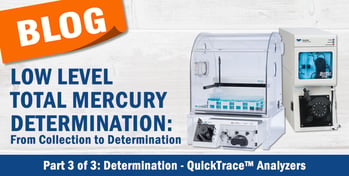
Teledyne Leeman Labs offers multiple mercury (Hg) analyzers which can determine total mercury concentrations in samples at the ultra-trace level. The final installment of this three-part blog series will be an introduction to the QuickTrace line of mercury analyzers: the QuickTrace M-7600 and the QuickTrace M-8000.
Determining which analyzer would be best for your aqueous samples will depend on your answer to these two questions:
- What analytical technique is designated by your required (or preferred) regulatory method?
- What detection limit do you need to reach?
Each regulatory method will specify the analytical technique that is acceptable. The most common techniques for mercury analysis in aqueous samples are cold vapor atomic absorption (CVAA) and cold vapor atomic fluorescence (CVAF). CVAF is often paired with gold trap amalgamation to increase the sensitivity.
The QuickTrace M-7600
The QuickTrace M-7600 uses CVAA as its principle analytical technique. It is used to analyze samples that include waters and wastewaters, soils and sediments, and biological tissues and fluids. The QuickTrace M-7600 is ideal for ultra-trace mercury quantitation at sub ng/L levels; it also is capable of reaching the high µg/L range.
The QuickTrace M-7600 operates by continuous flow. Aqueous samples and reagents are pumped to the Gas Liquid Separator (GLS) via the peristaltic pump. Inert gas sweeps the elemental mercury out of the separator and through a dryer to remove water vapor. The dry gas flows through the detector where sample absorbance is measured using a double beam optical system. Some performance highlights for this instrument include:
- Ultra-trace detection limits, <0.5 ng/L IDL
- Linearity greater than 4 orders of magnitude
- Dynamic range, <0.5 ng/L to >500 µg/L
- Typical run time per sample, 60-120s
The QuickTrace M-7600 is the gold standard for CVAA mercury analysis. It is favored by large laboratory networks around the globe for its accuracy, stability, and reliability.
The QuickTrace M-8000
If you are required to use an atomic fluorescence technique or need a detection limit below 0.5 ng/L, the QuickTrace M-8000 will be the best fit for your laboratory. The QuickTrace M-8000 detects mercury in aqueous samples by chemical reduction, with or without gold trap pre-concentration, followed by atomic fluorescence. This instrument has three modes of operation: continuous flow, single gold trap amalgamation, and double gold trap amalgamation. These different modes allow the QuickTrace M-8000 to be versatile enough to analyze samples <0.05 ng/L to >400 µg/L, while easily achieving ultra-trace detection limits required for methods like EPA 1631 and 245.7. These modes can be changed within the software and do not require any hardware or tubing changes.
Continuous flow mode is very similar in operation to the QuickTrace M-7600 but with increased sensitivity and therefore lower detection limits. While this mode is not as sensitive as the gold trap modes, it has a faster analysis time. We consistently achieve non-gold-trap instrument detection limits of <0.1 ng/L using less than 10mL of sample.
Gold trap amalgamation greatly increases the sensitivity and therefore allows for detection of mercury in the sub-ng/L range. When the sample gas flows through the gold trap, the mercury is removed from the gas stream. Once collected, the gold trap is heated to release the mercury back into the gas stream and towards the fluorescence detector. This method is highly precise and takes longer than continuous flow methods. The QuickTrace M-8000 can reach instrument detection levels as low as 50pg/L while utilizing gold trap amalgamation mode. The QuickTrace M-8000 was made to satisfy the lower and lower limits required for clean water analyses, such as U.S. Environmental Protection Agency 1631.
Teledyne Leeman Labs’ mercury analyzers are a cornerstone of environmental laboratories around the globe. Visit the links below to read ultra-trace Application notes for methods such as USEPA 1631, USEPA 245.7, and ISO 17852.
- AP-M8001 Mercury Determination in Coastal Seawater, BCR-579, EPA Method 1631 (Performance Based Mode), using the CETAC QuickTrace™ M-8000 CVAFS
- AN1506 M8000 Groundwater EPA 245.7 VS ISO 17852
- AP-M7600-002 Mercury Analysis of Coastal Seawater by CVAAS Ultra Trace
Please follow this series as we cover a range of tips and tools that can help you.
- Part one is linked here, Low Level Total Mercury Determination: From Collection to Determination
- Part two is linked here, Low-Level Total Mercury Determination: From Collection to Determination: Part 2 - Digestion: Chemicals and Procedure
For more information on Leeman Labs Mercury Analyzers or if you would like to someone to contact you - click the button below.

